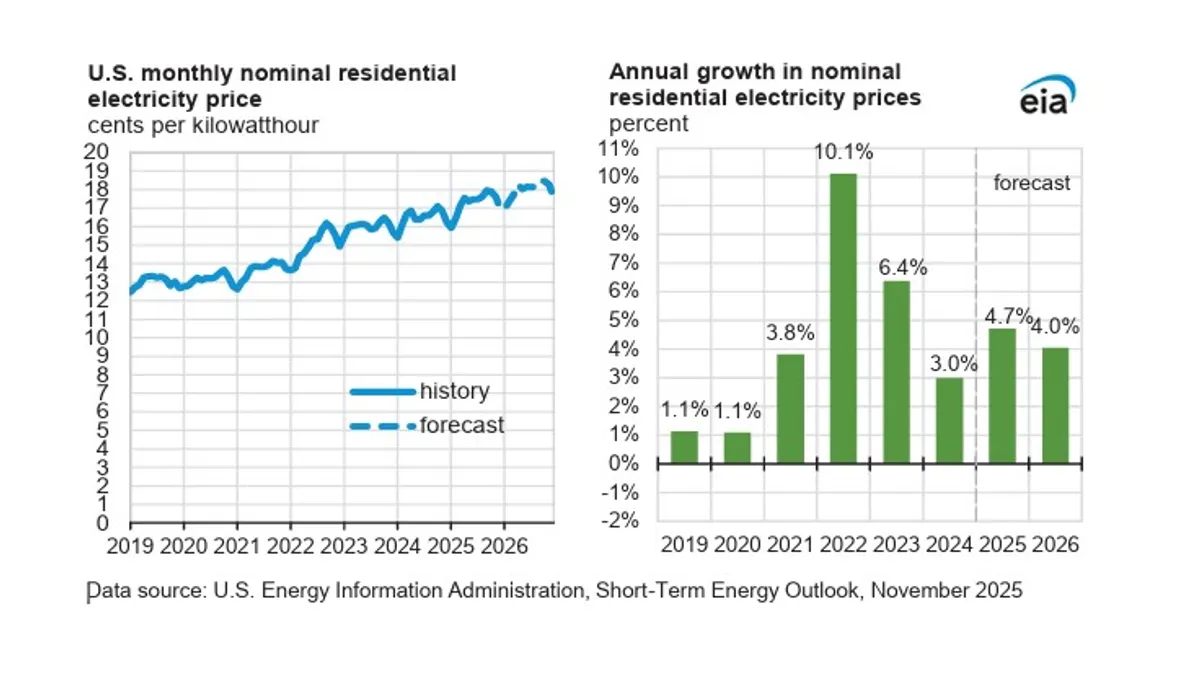Dive Brief:
- Xendee Corp., a distributed energy design and operations platform, is partnering with Eaton to “deliver a fully integrated microgrid solution” for hospitals, data centers and other critical facilities, the companies said Aug. 8.
- The collaboration pairs Eaton’s microgrid hardware and engineering expertise with Xendee’s AI-powered, “hardware-agnostic” microgrid optimization software. It gives microgrid operators tools to manage integrated solar panels, batteries, generators, combined heat and power systems and other energy resources for cost savings, improved resilience, reduced emissions and longer equipment lifespans, Eaton and Xendee said.
- Eaton also led a series B funding round in which it took a minority stake in the Las Vegas-based startup, Xendee Chief Technology Officer Michael Stadler said in an interview.
Dive Insight:
The International Energy Agency, which models global demand for electricity and liquid fuels, says AI is both a challenge and opportunity for energy utilities and end-users.
Electricity demand from AI data centers and other centralized computing facilities will double over the next five years, the IEA says, straining the power grid in some regions and increasing the risk of blackouts for customers. At the same time, widespread, AI-supported interventions to improve building efficiency could reduce annual global power demand by 300 terawatt-hours, equivalent to taking Australia and New Zealand off the grid, the agency says.
Xendee says its platform uses artificial intelligence to model and control more than 25 energy technologies in operational or in-design microgrids spanning more than a dozen value streams, such as electric vehicle charging or utility demand charge reduction.
“The challenge [with microgrids] is these are not quite off-the-shelf yet,” Stadler said. “There is a whole bunch of analysis that you need to do and that is why we started the company.”
Xendee’s AI-powered solution can reduce microgrid design costs and timelines, he said. Previously, it might have taken a year and $500,000 to size a microgrid battery. That same process now takes a few days and a small fraction of the cost, he said.
On the design side, Xendee helps microgrid developers and customers find ideal sites “in minutes, not months” while optimizing the technology mix at each location. The company says its microgrid design modeling costs come in around 13% of the industry average, or less than 1% of total project costs.
For operators, Xendee’s microgrid control solution enables real-time operational adjustments that show “significant cost savings over existing hardware and rule-based microgrid controllers,” the company says.
The partnership with Eaton enables Xendee to tap the Ohio-based OEM’s hardware expertise to offer a wider range of solutions as facility operators turn to microgrids for greater control over energy costs, reliability and sustainability, Stadler said.
Eaton’s “Everything as a Grid” approach suggests it’s bullish on microgrids as a key component of facilities’ energy posture. The approach envisions a more decentralized energy system where microgrid-supported data centers, commercial buildings and even homes act as nodes in a more resilient power grid.
“[When] you generate the energy where you need it … you can reduce the burden on the power distribution system,” Stadler said. “There’s too much market power on the utility side and we need to decentralize the system to save on cost.”
At the same time, microgrids remain key for resilience at critical facilities such as hospitals and military bases, multi-use facilities such as university campuses, and in remote communities or mining operations disconnected from the main grid, Stadler said.
The optimal solution for facilities and communities like these is often more sophisticated than simply running a bank of diesel generators, he said. Data centers, for example, are good candidates for combined heat-and-power infrastructure, which recovers waste heat for use in climate control systems and generally operates at higher total efficiencies than generators alone.















